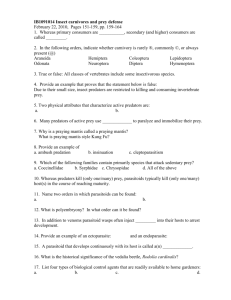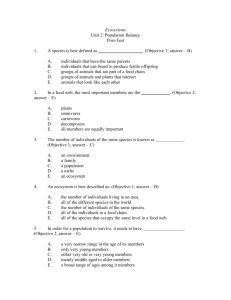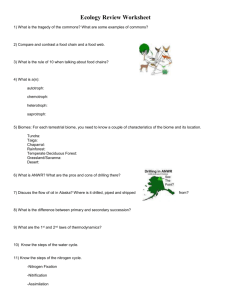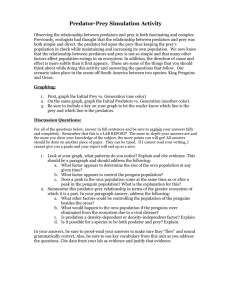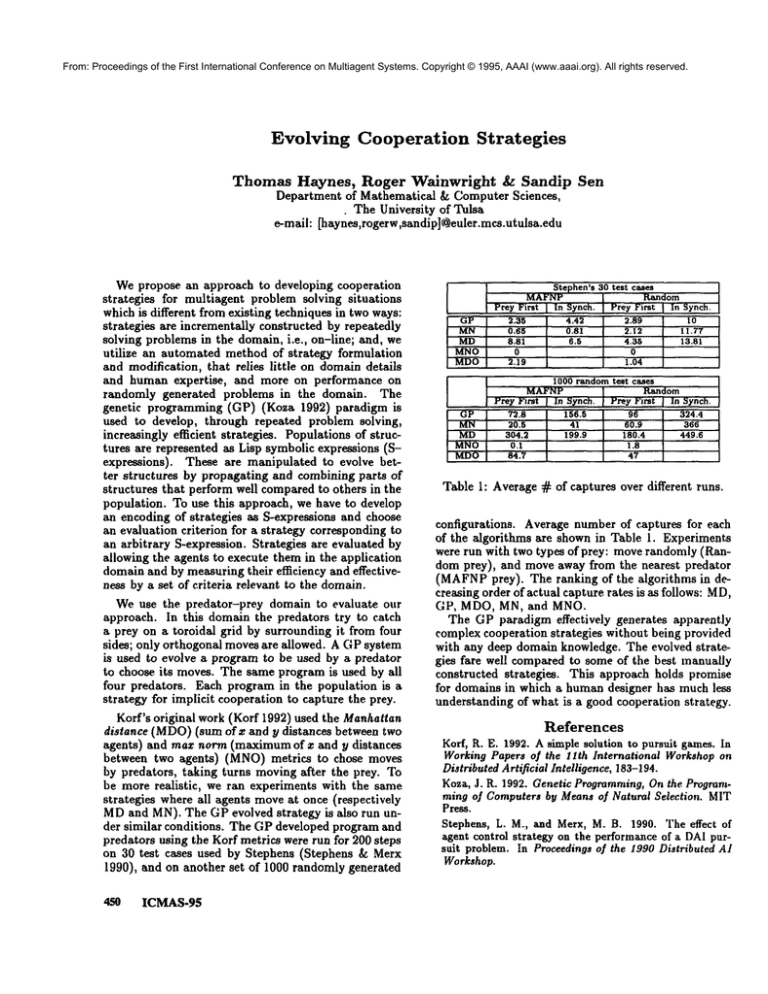
From: Proceedings of the First International Conference on Multiagent Systems. Copyright © 1995, AAAI (www.aaai.org). All rights reserved.
Evolving
Thomas Haynes,
Cooperation
Roger
Strategies
Wainwright
& Sandip
Sen
Department of Mathematical g~ Computer Sciences,
The University of Tulsa
e-mail: [haynes,rogerw,sandip]C@euler.mcs.utulsa.edu
Wepropose an approach to developing cooperation
strategies for multiagent problemsolving situations
whichis different fromexisting techniquesin two ways:
strategies are incrementally constructed by repeatedly
solving problemsin the domain,i.e., on-line; and, we
utilize an automatedmethodof strategy formulation
and modification, that relies little on domaindetails
and humanexpertise, and more on performance on
randomly generated problems in the domain. The
genetic programming(GP) (Koza 1992) paradigm
used to develop, through repeated problem solving,
increasingly efficient strategies. Populationsof structures are represented as Lisp symbolicexpressions (Sexpressions). These are manipulated to evolve better structures by propagating and combiningparts of
structures that performwell comparedto others in the
population. To use this approach, we have to develop
an encodingof strategies as S-expressions and choose
an evaluation criterion for a strategy correspondingto
an arbitrary S-expression. Strategies are evaluated by
allowing the agents to execute themin the application
domainand by measuring their efficiency and effectiveness by a set of criteria relevant to the domain.
Weuse the predator-prey domain to evaluate onr
approach. In this domain the predators try to catch
a prey on a toroidal grid by surrounding it from four
sides; only orthogonal movesare allowed. A GPsystem
is used to evolve a program to be used by a predator
to choose its moves.The sameprogramis used by all
four predators. Each program in the population is a
strategy for implicit cooperationto capture the prey.
Korf’s original work (Korf 1992) used the Manhattan
distance (MDO)(sum ofa~ and y distances between
agents) and max norm (maximumof z and y distances
between two agents) (MNO)metrics to chose moves
by predators, taking turns movingafter the prey. To
be more realistic, we ran experiments with the same
strategies whereall agents moveat once (respectively
MDand MN).The GPevolved strategy is also run under similar conditions. The GPdevelopedprogramand
predators using the Korf metrics were run for 200 steps
on 30 test cases used by Stephens (Stephens & Merx
1990), and on another set of 1000randomlygenerated
4S0
ICMAS-9$
Ste >hen’s 30 test cases
Random
Prey First I In Synch.
2.89
I0
2.12
11.77
4.35
13.81
0
1.04
I Prey First
MAFNP
[ In Synch.
GP
2.35
4.42
MN
0.65
0.81
MD
8.81
6.5
MNO
0
MDO
2.19
GP
MN
MD
MNO
MDO
1000 random teat cases
Random
Prey First
MAFNP
Prey First I In Synch.
[ In Synch.
72.8
156.5
96
324.4
20.5
41
60.9
366
304.2
199.9
180,4
449.6
0.1
1.8
84.7
47
Table 1: Average ~ of captures over different runs.
configurations. Average number of captures for each
of the algorithms are shown in Table 1. Experiments
were run with two types of prey: moverandomly (Random prey), and move away from the nearest predator
(MAFNPprey). The ranking of the algorithms in decreasing order of actual capture rates is as follows: MD,
GP, MDO, MN, and MNO.
The GP paradigm effectively generates apparently
complex cooperation strategies without being provided
with any deep domain knowledge. The evolved strategies fare well compared to some of the best manually
constructed strategies. This approach holds promise
for domains in which a humandesigner has much less
understanding of what is a good cooperation strategy.
References
Korf, R. E. 1992. A simple solution to pursuit games. In
Working Papers of the llth International
Workshop on
Distributed Artificial
Intelligence,
183-194.
Koza, J. R. 1992. Genetic Programming, On the Programming of Computers by Means of Natural Selection.
MIT
Press.
Stephens,
L. M., and Merx, M. B. 1990. The effect
of
agent control strategy on the perforlna~ce
of a DAI pursuit problem. In Proceedings of the 1990 Distributed
AI
Workshop.


